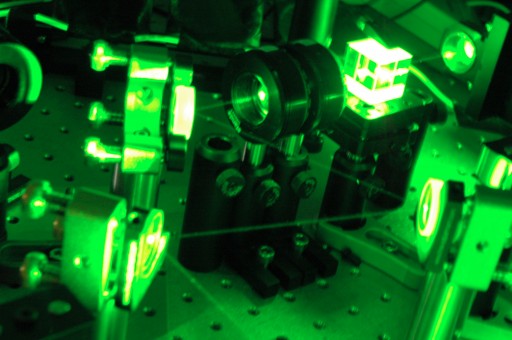A new scheme for photonic quantum computing
October 14, 2011

Preparation setup for the strong green pump laser used for enhancing the nonlinearity for coherent photonic conversion (credit: IQOQI Wien)
“Coherent photon conversion” could potentially overcome the unresolved problems for optical implementations of quantum computing. An international team of scientists led by researchers from the Vienna Center for Quantum Science and Technology (VCQ) at the University of Vienna (group of Anton Zeilinger) introduced this new scheme this week in Nature.
The new scheme provides a method of coherent conversion between different photon states and is based on enhancing the nonlinearity of a medium by a strong laser field. The method paves a road to solving all open challenges for optical quantum computation, according to the researchers.
Nonlinear optical quantum computer
For example, deterministically doubling single photons solves the preparation and measuring problems, and a novel type of photon-photon interaction gives efficient quantum gates.
This new quantum optics toolbox opened up by “coherent photon conversion” promises to lead to a nonlinear optical quantum computer.
In a first series of experiments, the group uses photons and highly non-linear glass fibers for a proof-of-principle demonstration of a process suitable for implementing the scheme. While deterministic operation has yet to be achieved, the authors’ results suggest how this might be possible with sophisticated optical technologies, such as using highly nonlinear glasses and stronger lasers. The general idea of “coherent photon conversion” can also be applied to various other physical systems, like atoms or nanomechanical devices.
This work was carried out as a joint effort by researchers of the Vienna Center for Quantum Science and Technology (VCQ) of the University of Vienna, the Institute for Quantum Optics and Quantum Information Vienna (IQOQI) of the Austrian Academy of Sciences, the National Institute of Informatics and the NTT Basic Research Laboratories (NTT Corporation) in Japan, and the Centre for Engineered Quantum Systems at the University of Queensland in Australia. It was supported by the European Research Council (Advanced Grant QIT4QAD), the Austrian Science Fund (grant F4007, an Erwin Schroedinger Fellowship, the Vienna Doctoral Program CoQuS FWF W121), the European Commission (QU-ESSENCE and QAP), the John Templeton Foundation and in part by the Japanese FIRST programme and the Ontario Ministry of Research and Innovation.
Ref.: N. K. Langford, et al., Efficient quantum computing using coherent photon conversion, Nature, 2011; [DOI:10.1038/nature10463]